RuSSIR Music Hackathon 2013: how it was
On the night of September 20-21, the first Russian music hackathon RuSSIR Music Hackathon was held in the framework of the VII international school-conference on information retrieval RuSSIR 2013 in Kazan. As the main organizer, I would like to present a story about this event. This post is dedicated to the impressions that an eyewitness of the event could have received, and the next post will contain more exclusive information - the organizer's notes.
Our event was supported by the Kazan Federal University , the Higher School of ITIS KFU , NP ROMIP , and the main sponsor and partner was Zvooq , the music service of Dream Industries .

')
So, the leitmotif of our hackathon was the creation of applications in the field of music in 24-hour mode. Participants were not limited by the type of application or platform for implementation. Due to the fact that the event was held on the same days as the RuSSIR school, our hackathon brought together a rather unique list of participants (34 people in total): mostly, they were young scientists from different cities of Europe and Russia, as well as Kazan professional developers . For this reason, English has become the main language of communication during the event. In addition, the venue itself — the university’s lecture hall — gave a special atmosphere: instead of a night of museums, a night at the university!
The opening ceremony was brief: most of the information on the format of the event was available on the official page , and almost everyone was aware of what was happening. The next item is the presentation of trainers (coaches), i.e. experts on various technologies. They could help hackathon members with implementation tips. On our hackathon, the coaches were the guys from Dream Industries (see the following photo from left to right, except for me in a red T-shirt): Alexey Kralin, Samat Galimov, Jelle Akkerman and Renat Sarymsakov. The presentation of the (yet closed) API of the Zvooq music service was a real exclusive of our hackathon: participants could use it for their applications and consult with trainers on all issues that arise.
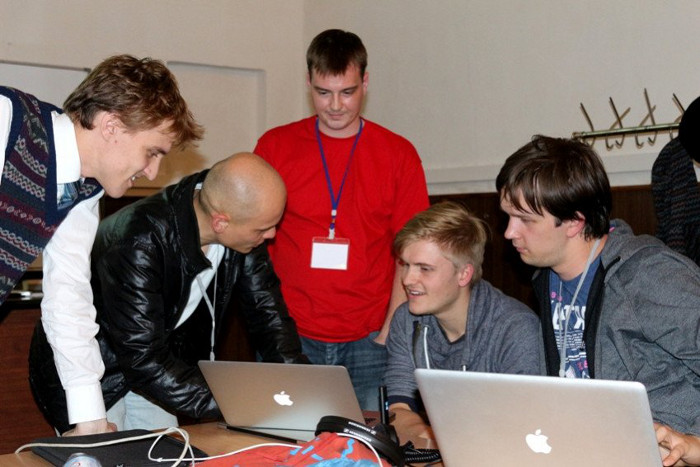
Then followed a very crucial stage - the presentation (or pitching - presentation) of ideas for projects. We gave participants no more than 10 minutes to present the idea and answer questions from the audience. Ideas were posted on our special page located on a simple and convenient Hacker League resource, which participants could also use to form teams online (the team was allowed to have no more than 5 people). It's nice that most of the ideas were invented almost on the fly: it means that the participants were actively involved in the creative process from the very beginning. Discussion of ideas and the formation of teams was successfully combined with dinner, which was served in a cafe near the venue.
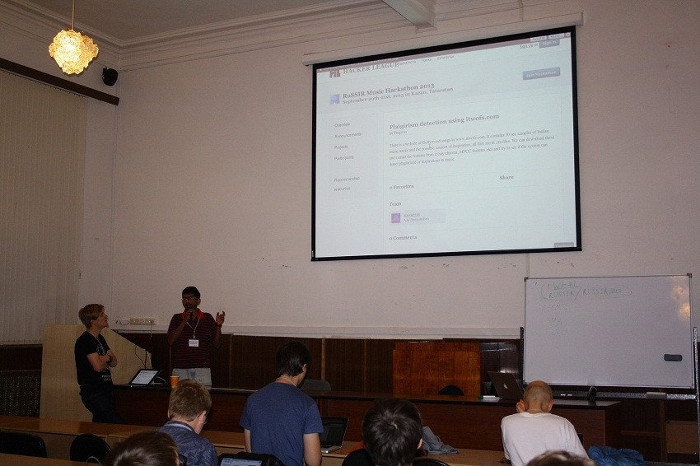
After everyone ate and returned to the audience, the work began to boil ...

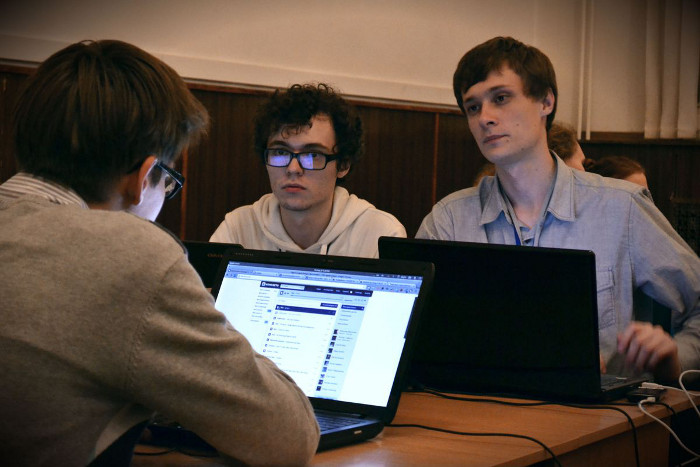
Our coaches did not get bored during the hackathon: they not only advised the participants, but also worked intently on their idea - friends.fm , which was also presented, but already out of competition.

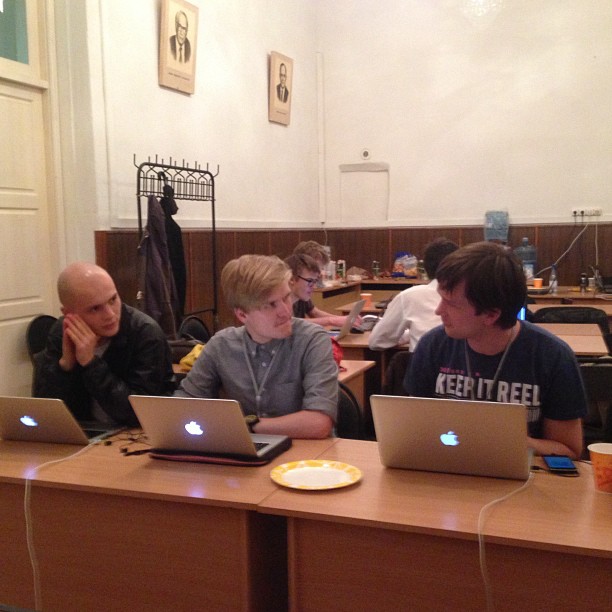
During implementation, we displayed all relevant information on the screen using the Tweetwally resource configured for the #russir hashtag. At night there was one coffee break and two pizza deliveries. In the morning - breakfast again in the same cafe. In addition (and this is the know-how of our hakaton), we provided participants with a free opportunity to relax in the 16-bed room of the hostel, located not far from the venue.
After lunch, the teams completed the implementation and began to prepare their performances. At the same time, a countdown came up on the screen, which at exactly the designated time signaled the end of the implementation phase.
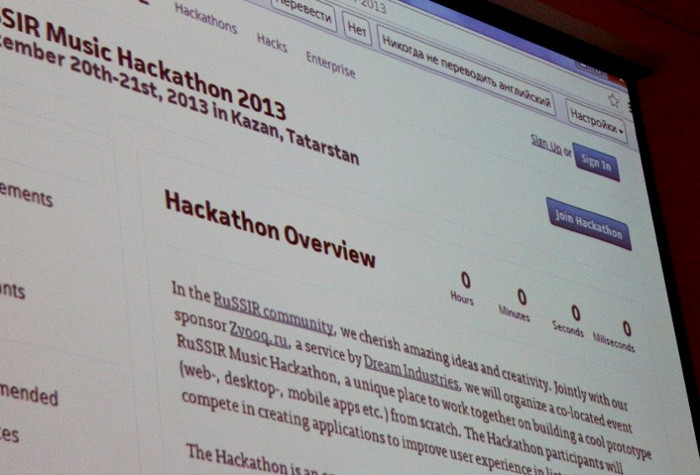
Finally, we turn to the most interesting - a review of the submitted projects. A total of 7 projects were presented (hereinafter in the order of presentations):
The schedule of the final speeches was the same for everyone - 5 minutes and about the same time for questions from the audience. I would like to emphasize that they were welcomed, presented and discussed not even complete implementations. It is important to remember that there are no negative experiences on hackathons: the main thing is to try to learn something new and share knowledge.

Using the general voting method (each participant could vote for the project he liked, excluding his own), the winner of our hackathon was identified - the TwiMoMusic project team consisting of: Ilya Chetverkin, Mikhail Nokel, Katerina Malakhova, Ramil Gataullin and Kristina Sabirova. The guys received prizes from the organizers - a set of headphones made by Sennheiser, Sony and Razer Electra. The special prize from our sponsor Zvooq - a paid trip to Moscow with a visit to the Dream Industries office and an iPad mini - was received by the team of the Pintrack project: Vladimir Protasevich, Fyodor Nikolaev and Marcel Sidikov. On behalf of the organizing team, I once again congratulate the winners and thank all the hackathon members for the most interesting projects!

In conclusion, I would like to thank my colleagues who helped me a lot during the organization:
Photo by Nikita Zhiltsov, Ilya Ivanov ( Tatcenter ) and Alina Korneeva (press-center of ICM-IT-VMK KFU). The remaining photos are in an open album on Facebook.
Our event was supported by the Kazan Federal University , the Higher School of ITIS KFU , NP ROMIP , and the main sponsor and partner was Zvooq , the music service of Dream Industries .

')
So, the leitmotif of our hackathon was the creation of applications in the field of music in 24-hour mode. Participants were not limited by the type of application or platform for implementation. Due to the fact that the event was held on the same days as the RuSSIR school, our hackathon brought together a rather unique list of participants (34 people in total): mostly, they were young scientists from different cities of Europe and Russia, as well as Kazan professional developers . For this reason, English has become the main language of communication during the event. In addition, the venue itself — the university’s lecture hall — gave a special atmosphere: instead of a night of museums, a night at the university!
The opening ceremony was brief: most of the information on the format of the event was available on the official page , and almost everyone was aware of what was happening. The next item is the presentation of trainers (coaches), i.e. experts on various technologies. They could help hackathon members with implementation tips. On our hackathon, the coaches were the guys from Dream Industries (see the following photo from left to right, except for me in a red T-shirt): Alexey Kralin, Samat Galimov, Jelle Akkerman and Renat Sarymsakov. The presentation of the (yet closed) API of the Zvooq music service was a real exclusive of our hackathon: participants could use it for their applications and consult with trainers on all issues that arise.

Then followed a very crucial stage - the presentation (or pitching - presentation) of ideas for projects. We gave participants no more than 10 minutes to present the idea and answer questions from the audience. Ideas were posted on our special page located on a simple and convenient Hacker League resource, which participants could also use to form teams online (the team was allowed to have no more than 5 people). It's nice that most of the ideas were invented almost on the fly: it means that the participants were actively involved in the creative process from the very beginning. Discussion of ideas and the formation of teams was successfully combined with dinner, which was served in a cafe near the venue.

After everyone ate and returned to the audience, the work began to boil ...


Our coaches did not get bored during the hackathon: they not only advised the participants, but also worked intently on their idea - friends.fm , which was also presented, but already out of competition.


During implementation, we displayed all relevant information on the screen using the Tweetwally resource configured for the #russir hashtag. At night there was one coffee break and two pizza deliveries. In the morning - breakfast again in the same cafe. In addition (and this is the know-how of our hakaton), we provided participants with a free opportunity to relax in the 16-bed room of the hostel, located not far from the venue.
After lunch, the teams completed the implementation and began to prepare their performances. At the same time, a countdown came up on the screen, which at exactly the designated time signaled the end of the implementation phase.

Finally, we turn to the most interesting - a review of the submitted projects. A total of 7 projects were presented (hereinafter in the order of presentations):
- MoodTrackr: Music Visual Space . This web application creates a graphical representation of the last.fm user's mood based on the last listened music. “Mood” is a 12-dimensional vector, a superposition of the vectors of all the listened users of the tracks. The application learns about compositions by lists of adjectives in tags on last.fm and in reviews, using the measure of similarity between the found and basic adjectives based on the Wordnet thesaurus.
- Pintrack This Chrome browser extension allows you to “attach” a music track to any page on the Internet, so that other users can listen to it while surfing the web. The application works with the Zvooq API.
- Tiersenize . This application set an ambitious goal - to get a 10-second audio file as a compressed presentation of a whole music album.
- TwiMoMusic . This is a web application that in real time extracts tweets about music, analyzes the mood of musical compositions, extracts the geolocation of the user according to his profile and displays the mood map for different cities of the world. This information can be used further to recommend music that corresponds to the general mood of the geographical area.
- friends.fm (out of competition). This minimalistic MacOS application plays music of friends from the Zvooq catalog.
- eyeListen . This mobile application allows you to generate your own soundtrack by selecting a music track for this image.
- djturk . This application emulates a part of the work of a disc jockey and is intended for the selection of the next music track, based on the playing history of the current track in past sets of various disc jockeys. The application uses data from the MixCloud service.
The schedule of the final speeches was the same for everyone - 5 minutes and about the same time for questions from the audience. I would like to emphasize that they were welcomed, presented and discussed not even complete implementations. It is important to remember that there are no negative experiences on hackathons: the main thing is to try to learn something new and share knowledge.

Using the general voting method (each participant could vote for the project he liked, excluding his own), the winner of our hackathon was identified - the TwiMoMusic project team consisting of: Ilya Chetverkin, Mikhail Nokel, Katerina Malakhova, Ramil Gataullin and Kristina Sabirova. The guys received prizes from the organizers - a set of headphones made by Sennheiser, Sony and Razer Electra. The special prize from our sponsor Zvooq - a paid trip to Moscow with a visit to the Dream Industries office and an iPad mini - was received by the team of the Pintrack project: Vladimir Protasevich, Fyodor Nikolaev and Marcel Sidikov. On behalf of the organizing team, I once again congratulate the winners and thank all the hackathon members for the most interesting projects!

In conclusion, I would like to thank my colleagues who helped me a lot during the organization:
- Fedor Nikolaev ( fsqcds ),
- Alik Kirillovich ( Alik_Kirillovich ),
- Marat Shigapova,
- Marcel Sidikov.
Photo by Nikita Zhiltsov, Ilya Ivanov ( Tatcenter ) and Alina Korneeva (press-center of ICM-IT-VMK KFU). The remaining photos are in an open album on Facebook.
Source: https://habr.com/ru/post/193828/
All Articles